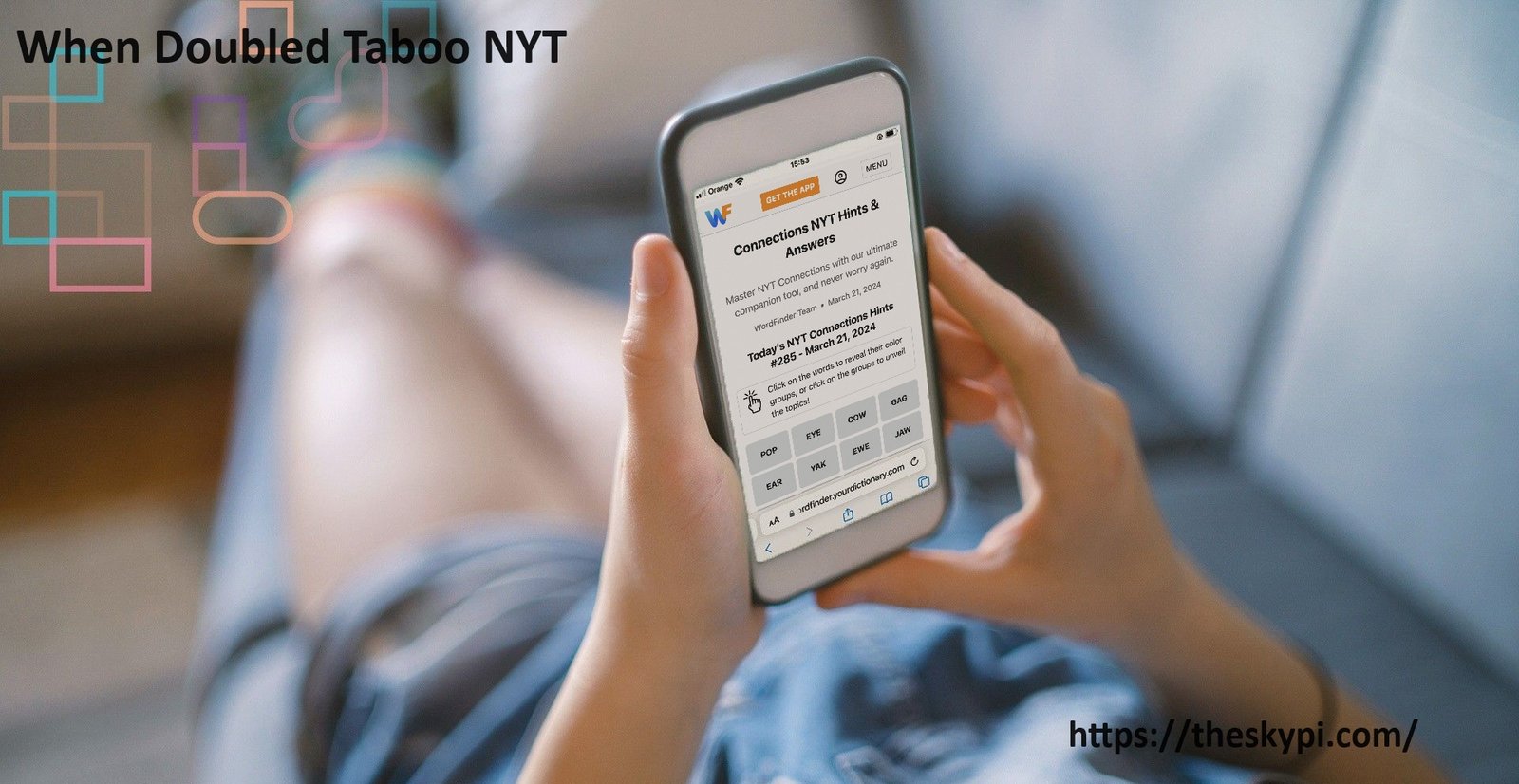Introduction
When Doubled Taboo NYT, Crossword puzzles have been a staple of newspapers and magazines for over a century. Among the most prestigious and challenging of these puzzles is the one published by The New York Times (NYT). One of the intriguing aspects of NYT crosswords is the use of clever, often cryptic clues that challenge solvers in unique ways. One such clue that has captivated and perplexed solvers is “When Doubled Taboo NYT.” This phrase has appeared multiple times in various crossword puzzles, prompting solvers to explore its meaning and the word it references. In this article, we’ll delve into the history, meaning, and context of this intriguing crossword clue.
The Origins of the NYT Crossword Puzzle
The New York Times published its first crossword puzzle on February 15, 1942, during the height of World War II. The introduction of the crossword was met with skepticism, as some critics viewed it as a frivolous distraction. However, the puzzle quickly gained popularity, and its reputation for challenging and intellectually stimulating content grew.
The NYT crossword is known for its clever clues and wordplay, often requiring solvers to think outside the box. Clues can be straightforward definitions, puns, anagrams, or cultural references. The clue “When Doubled Taboo NYT” falls into the category of cryptic clues, which are designed to be deliberately misleading.
Understanding the Clue: “When Doubled Taboo NYT”
To decode the clue “When Doubled Taboo NYT,” we must first understand the structure of the clue itself. In cryptic crossword clues, every part of the clue provides information that leads to the answer. The phrase “When Doubled” suggests that a certain word, when repeated, will form a word or phrase synonymous with “Taboo.”
The answer to this clue is “NO.” When doubled, “NO” becomes “NO NO,” a phrase that signifies something forbidden or taboo. This type of wordplay is a hallmark of NYT crosswords, showcasing the puzzle creators’ ingenuity and the need for solvers to approach the puzzle with a flexible mindset.
The Significance of “NO NO” in Language and Culture
The phrase “NO NO” is deeply embedded in the English language and culture as a term for something prohibited or frowned upon. It is often used to describe actions, behaviors, or topics that are off-limits or inappropriate. For example, in a classroom setting, a teacher might say, “Talking during the test is a big no-no.” In this context, “NO NO” conveys a clear sense of disapproval and restriction.
The use of “NO NO” as a synonym for taboo extends beyond everyday language. It appears in literature, movies, and music, reinforcing its status as a culturally recognized term for forbidden actions or subjects. This widespread usage makes it a fitting answer for the cryptic crossword clue, as solvers are likely to be familiar with the phrase and its connotations.
The Role of Wordplay in Crossword Puzzles
Wordplay is an essential element of crossword puzzles, particularly those published by The New York Times. It adds an extra layer of challenge and enjoyment for solvers, requiring them to think creatively and consider multiple interpretations of a clue. The clue “When Doubled, Taboo” is a prime example of wordplay in action, as it relies on solvers recognizing the repeated word and its cultural significance.
The Evolution of NYT Crossword Clues
Over the decades, NYT crossword clues have evolved to reflect changes in language, culture, and society. Early puzzles often feature straightforward definitions and classical references, but modern puzzles incorporate contemporary slang, pop culture references, and current events. This evolution keeps the puzzles relevant and engaging for a diverse audience.
The clue “When Doubled Taboo NYT” exemplifies the blend of traditional wordplay and modern sensibility that characterizes NYT crosswords. It challenges solvers to draw on their linguistic knowledge and cultural awareness, highlighting the puzzle’s role as both a mental exercise and a reflection of contemporary language.
Strategies for Solving Cryptic Clues
Cryptic crossword clues like “When Doubled Taboo NYT” can be daunting, but there are strategies that solvers can use to approach them effectively:
- Identify the Definition: In many cryptic clues, one part of the clue is a straightforward definition of the answer. In this case, “Taboo” serves as the definition.
- Look for Wordplay Indicators: Phrases like “When Doubled” signal that wordplay is involved. Recognizing these indicators can help solvers understand how the clue is constructed.
- Consider Multiple Meanings: Cryptic clues often rely on double meanings or puns. Solvers should think about different interpretations of the words in the clue.
- Use Crossword Solving Resources: Online dictionaries, crossword-solving tools, and forums can provide valuable assistance when tackling challenging clues.
- Practice and Patience: Solving cryptic crosswords takes practice and patience. Regularly working on puzzles can help solvers become more familiar with common clue structures and wordplay techniques.
The Appeal of the NYT Crossword
The enduring popularity of The New York Times crossword puzzle can be attributed to several factors:
- Intellectual Challenge: The puzzles are known for their difficulty and the intellectual stimulation they provide. Solvers enjoy the mental exercise and the sense of accomplishment that comes with completing a challenging puzzle.
- Variety and Creativity: NYT crosswords feature a wide range of clue types and themes, keeping the puzzles fresh and interesting. The creativity of the clues, including those with clever wordplay, adds to the appeal.
- Cultural Relevance: The puzzles reflect contemporary language and culture, making them relevant to modern solvers. Clues often reference current events, pop culture, and trends, creating a connection between the puzzles and the world outside.
- Community and Tradition: Solving the NYT crossword is a cherished tradition for many individuals and families. The puzzles foster a sense of community among solvers who share tips, discuss clues, and celebrate their successes.
Conclusion
The clue “When Doubled Taboo NYT” exemplifies the ingenuity and challenge of The New York Times crossword puzzle. By understanding the wordplay and cultural significance behind the answer “NO NO,” solvers can appreciate the cleverness of the clue and the broader appeal of NYT crosswords. These puzzles continue to captivate and challenge solvers, offering a blend of intellectual stimulation, cultural relevance, and creative wordplay that has made them a beloved tradition for over 80 years. Whether you’re a seasoned solver or new to the world of crosswords, tackling these puzzles provides a rewarding and enjoyable experience that showcases the beauty and complexity of the English language When Doubled Taboo NYT.
FAQs: When Doubled Taboo NYT
1. What does the clue “When Doubled Taboo NYT” mean in crossword puzzles?
In New York Times (NYT) crossword puzzles, the clue “when doubled, taboo” typically refers to the word “NO.” When “NO” is doubled to form “NO NO,” it implies something that is forbidden or taboo.
2. How often does the clue “When Doubled Taboo NYT” appear in crossword puzzles?
The frequency of this clue varies, but it is a popular crossword clue and appears periodically. The NYT crossword is known for its clever and tricky clues, and “When Doubled Taboo NYT” is a classic example.
3. What are some other examples of similar crossword clues?
Other similar crossword clues might include:
- “When doubled, dance” for “CHA” (CHA-CHA)
- “When doubled, a Polynesian food” for “POI” (POI-POI)
- “When doubled, a Jamaican genre” for “SKA” (SKA-SKA)
4. Why are such clues used in crosswords?
These types of clues are used to add a layer of challenge and enjoyment to the puzzle. They often require solvers to think creatively and make connections between words and phrases in unconventional ways.
5. How can I get better at solving these types of clues?
To improve at solving these types of clues, you can:
- Practice regularly by solving a variety of crossword puzzles.
- Familiarize yourself with common crossword conventions and wordplay.
- Learn about frequently used words and phrases in crossword puzzles.
- Join online crossword communities and forums for tips and strategies.


